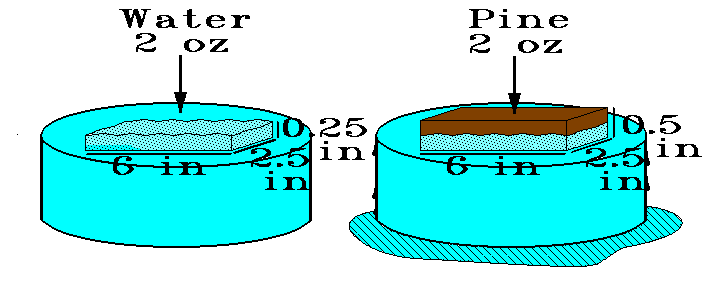
| Raingutter Boat Racing - | Breathing Life Into Your Boat |
This is a fundamental question that requires a fundamental understanding about objects in water! What makes something float? Simply put, an object will float on water whenever the volume of water it displaces is less than its own volume. Practically speaking that means the average density of a floating object is less than that of water.
For example, in the Raingutter Regatta, your boat can not weigh less than one or two ounces (see your local rules). How much water is displaced by a boat that weighs two ounces?
Let's figure it out. Water weighs 0.554 ounces per cubic inch (oz/in3). Then 2 ounces (oz) of water occupies 2 oz / 0.554 oz/in3 = 3.6 cubic inches (in3) of space.
The volume of water displaced by a two ounce boat is
3.6 cubic inches.
How much pine wood weighs 2 ounces? First we have to look up or measure the density of the wood. It is about 0.28 ounces per cubic inch, about half that of water. Then two ounces of wood occupies 2oz / 0.28 oz/in3 = 7.1 cubic inches of space.
That's why it floats! The wood takes up more space than the water for the same weight, so it floats.
Knowing this, we can say that if your boat's hull has a volume greater than 7.1 cubic inches, it will be heavier than two ounces!
What's more, the rules dictate that your boat must be 6 inches or less in length and 2.5 inches or less in width (check for your own race limits). For reasons of stability, you will always want your boat to have the most length and width allowable

That means your boat could have a surface of 6 in x 2.5 in = 15 square inches (in2). If it also weighs 2 oz, your hull will have a volume of 7.1 cubic inches. How thick is the hull? Divide the hull volume by the hull surface, 7.1 in3 / 15 in2 = 0.48 inches. Just about half an inch.
Where will the water line be on your hull? Divide the volume of water displaced by the hull surface, 3.6 in3 / 15 in2 = 0.24 inches. That's about a quarter of an inch, half way up your hull.
What is the most your boat can weigh? The rules allow your boat's hull to sink 1.25 inches below the water line. This is the maximum draft your boat can have. The most water your boat can displace is 6 in x 2.5 in x 1.25 in = 18.75 cubic inches of water. How much does that much water weigh? 18.75 in3 x 0.554 oz/in3 = 10.4 ounces.
That's a hull of 18.75 in3 / 0.28 oz/in3 = 39.3 cubic inches of pine wood. Divide by a 15 square inch surface and we get a hull that is 2.6 inches tall. That's the largest that would be allowed!
Just from the very basics of water displacement and buoyancy we already know about how large your hull can be and how high it can ride on the water!
| Smallest | Largest | |
|---|---|---|
| Weight | 2.0 oz | 10.4 oz |
| Hull Volume | 7.1 in3 | 39.3 in3 |
| Hull Height | 0.48 in | 2.6 in |
| Draft | 0.24 in | 1.25 in |
Remember everything you add to your hull, the mast, the sail, bumpers, paint, sealer, it all adds weight. If you cut your hull to make it two ounces, when you are done your boat will weigh more. If possible, weigh everything that will be attached to your hull first, then cut your hull to be that much less than two ounces.
Note, this procedure can be modified for other shapes. For a general shape,
| [Dry Dock] | [Title Page] |
| Raingutter Boat Racing - | Breathing Life Into Your Boat |
| Copyright © 1997, 2000, 2002, 2004 by Michael Lastufka, All rights reserved worldwide. | |